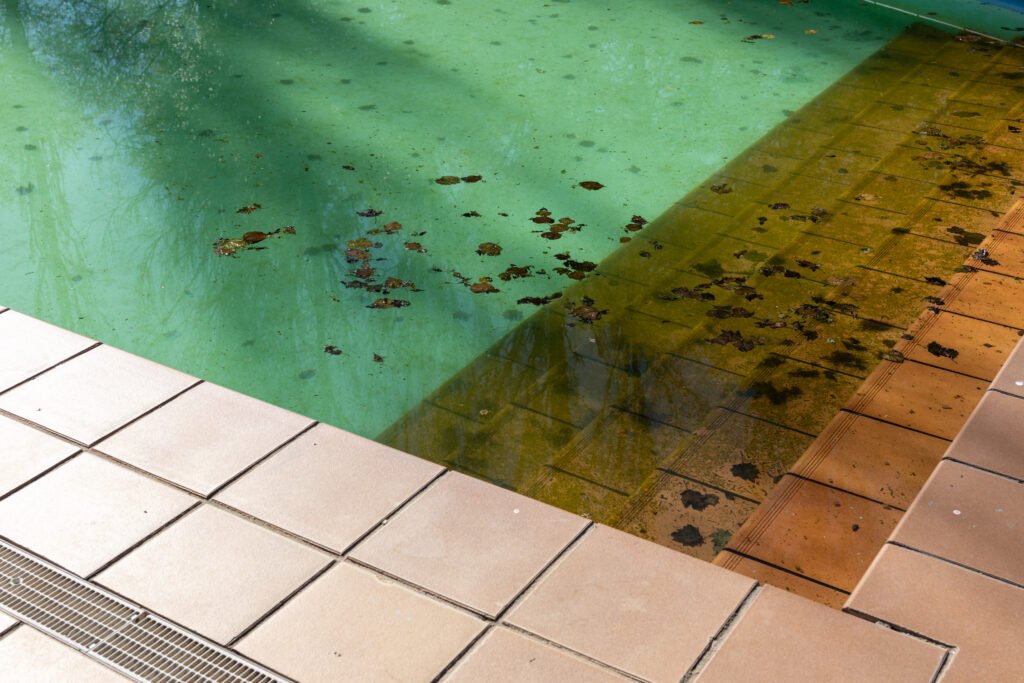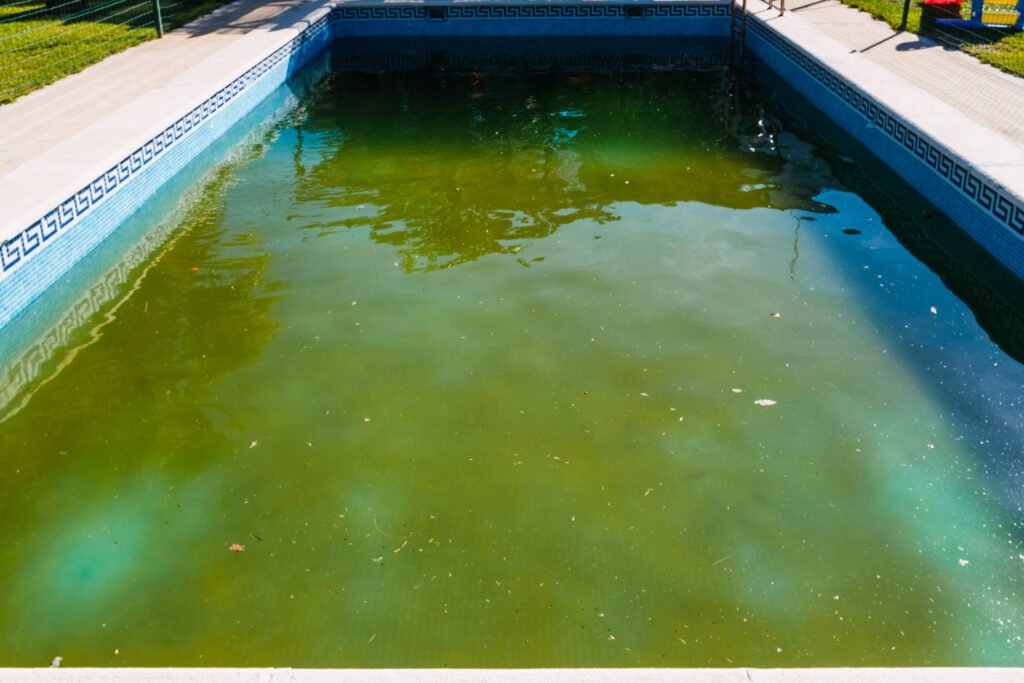Dealing with algae in a pool is essential for maintaining a clear and safe swimming environment. Algae growth in a swimming pool is a common issue that can be unsightly and pose health risks. Algae can thrive in pools with poor circulation, sanitation, or water balance. There are several types of pool algae, including green, black, pink, and yellow algae. It is important to identify the type of algae to determine the most effective treatment. To prevent and deal with algae growth, pool owners should regularly clean and vacuum the pool, sanitize the water with chlorine, and maintain proper water balance and filtration. Shocking the pool with chlorine can be an effective way to kill algae. Using an algaecide regularly can also help prevent algae growth. It is essential to regularly brush and scrub the pool walls and floors, as well as remove any debris or dead algae. Proper pool maintenance, including regular testing and balancing of chemicals, can help prevent algae from forming in the first place.
Key Takeaways
- Regular cleaning and vacuuming of the pool are important to prevent algae growth.
- Sanitizing the pool water with chlorine is essential for keeping algae at bay.
- Identifying the type of algae is crucial for effective treatment.
- Using an algaecide regularly can help prevent algae from growing in the pool.
- Proper pool maintenance, including testing and balancing chemicals, is vital for preventing algae formation.
Dealing with algae in a pool may require some effort, but the rewards are well worth it. By following proper pool maintenance practices and taking preventive measures, you can ensure a clear and algae-free swimming experience for yourself and your loved ones.
Understanding the Types of Pool Algae

To effectively treat algae in your pool, it’s important to understand the different types of pool algae and their characteristics. Algae growth in a swimming pool is a common issue that can be unsightly and pose health risks. Algae can thrive in pools with poor circulation, sanitation, or water balance. By identifying the specific type of algae in your pool, you can take targeted actions to eliminate it and prevent future growth.
Green algae is the most common type found in pools. It appears as a greenish tint on the pool walls and floor, often resembling a slimy coat. Green algae can spread rapidly, making the water cloudy and giving it an unpleasant odor. This type of algae is typically caused by insufficient chlorine levels or poor water circulation.
Black algae is more stubborn and harder to get rid of. It forms dark, black spots on the pool’s surfaces, especially in cracks and crevices. Black algae has deep root systems that make it resistant to normal chlorine treatments. It requires vigorous scrubbing and the use of specialized algaecides to eradicate completely.
Pink algae, also known as pink slime, is a type of bacteria that can appear in pools. It presents as pink or reddish patches on the pool walls, steps, or other surfaces. Unlike regular algae, pink algae can thrive in pools with high levels of sanitizing chemicals. Proper cleaning and the use of algaecides are necessary to eliminate this nuisance.
Yellow algae, often referred to as mustard algae, is another persistent type that can cling to pool surfaces. It appears as yellow or mustard-colored spots on the walls and may resist conventional chlorine treatments. Brushing and scrubbing the affected areas, along with the use of specialized algaecides, are essential to eliminate yellow algae.
Types of Pool Algae Summary:
| Algae Type | Characteristics |
|---|---|
| Green Algae | Greenish tint, slimy coat |
| Black Algae | Dark, black spots, resistant to normal treatments |
| Pink Algae | Pink or reddish patches, can thrive in high chemical levels |
| Yellow Algae | Yellow or mustard-colored spots, resistant to chlorine treatments |
Understanding the types of pool algae will help you take appropriate measures to treat and prevent their growth in your pool. Regular maintenance, proper water balance, and the use of suitable algaecides can keep your pool clear, clean, and inviting for a refreshing swim.
Preventing Algae Growth in Your Pool
Preventing algae growth in your pool is key to maintaining a clean and healthy swimming environment. Algae can quickly take hold and spread, turning your crystal-clear pool into a murky and uninviting mess. Fortunately, with proper pool maintenance, you can minimize the risk of algae growth and keep your pool looking its best.
Regular pool cleaning and maintenance are essential for algae prevention. This includes skimming the surface to remove leaves and debris, as well as vacuuming the pool to eliminate any settled dirt and algae spores. Brushing the pool walls and floors helps to dislodge any algae that may have started to form, making it easier to remove and reducing the risk of it spreading.
Another crucial aspect of algae control is proper water treatment. Sanitizing the water with chlorine or other suitable sanitizers helps to kill algae and prevent it from multiplying. Regularly testing and balancing the water’s pH, alkalinity, and sanitizer levels is vital for maintaining a healthy pool environment that is inhospitable to algae growth.
Additionally, using an algaecide can provide an extra layer of defense against algae. Algaecides are specially formulated chemicals designed to inhibit and prevent algae growth. Adding an algaecide to your pool regularly can help to keep algae at bay, reducing the likelihood of an outbreak.
Summary:
- Regular cleaning and maintenance, including skimming, vacuuming, and brushing, help prevent algae growth.
- Proper water treatment, including sanitizing the water and balancing chemical levels, is crucial for algae control.
- Using an algaecide regularly adds an extra layer of defense against algae growth.
By following these preventive measures and maintaining a diligent pool care routine, you can significantly reduce the risk of algae growth in your pool. Remember, prevention is always better than dealing with a full-blown algae outbreak. Keep your pool clean, sanitized, and properly balanced, and you’ll enjoy a beautiful and algae-free swimming experience all season long.
| Preventive Measures | Benefits |
|---|---|
| Regular cleaning and maintenance | Prevents algae growth and maintains pool aesthetics |
| Proper water treatment | Kills and inhibits algae, creates an inhospitable environment for growth |
| Use of algaecide | Additional defense against algae, reduces the risk of outbreaks |

Treating Algae Growth in Your Pool
When dealing with algae growth in your pool, there are effective treatment methods to eliminate and prevent its presence. Algae can quickly spread and make your pool water look green, cloudy, or even slimy. To restore the clarity and cleanliness of your pool, it’s important to take immediate action.
The first step in treating pool algae is to identify the type of algae that has invaded your pool. Different types of algae require specific treatment methods for effective removal. Green algae, for example, is the most common type and can be treated by shocking your pool with chlorine. This process involves adding a large dose of chlorine to kill the algae and then thoroughly brushing and scrubbing the pool walls and floors to remove any remaining traces. Black algae, on the other hand, can be more stubborn and may require the use of specialized algaecides and persistent brushing.
Along with the treatment of the algae itself, it’s essential to address the underlying causes of algae growth. Poor pool maintenance, lack of proper filtration, and imbalanced water conditions can all contribute to the formation of algae. Regular pool maintenance, including cleaning and vacuuming, will help remove debris that algae feed on and disrupt their growth. Additionally, maintaining proper water balance by regularly testing and adjusting the chemical levels will create an environment that is less favorable for algae to thrive.
| Treatment Methods | Description |
|---|---|
| Chlorine Shock | Adding a large dose of chlorine to kill algae and sanitise the pool. |
| Algaecides | Specialised chemicals designed to prevent and treat algae growth. |
| Brushing and Scrubbing | Physically removing algae from the pool walls and floors. |
| Proper Filtration | Ensuring the pool’s filtration system is functioning optimally to remove debris and prevent algae growth. |

By combining proper treatment methods and regular maintenance, you can effectively treat and prevent algae growth in your pool. Remember to always follow the manufacturer’s instructions when using chemicals and consult a professional if you encounter persistent or severe algae problems. With consistent care and attention, you can enjoy a clear and algae-free swimming pool throughout the year.
Maintaining proper water balance in your pool is vital to prevent algae growth and promote a clean swimming environment. Algae can thrive in pools with poor circulation, sanitation, or water balance, so it’s essential to stay on top of pool maintenance. Regular testing and balancing of chemicals, such as pH, alkalinity, and calcium hardness, will help create an environment that discourages algae growth.
To maintain proper water balance, start by testing the pool water regularly using a reliable testing kit. This will give you accurate readings of the chemical levels in your pool. Adjust the pH level between 7.2 and 7.6, as this is the ideal range for preventing algae growth. Additionally, maintain a proper alkalinity level between 80 and 120 parts per million (ppm) and calcium hardness level between 200 and 400 ppm.
Proper filtration is also crucial for maintaining water balance and preventing algae. Ensure that your pool’s filter is clean and functioning effectively. Regularly backwash or clean the filter as recommended by the manufacturer to remove any debris or contaminants that could contribute to algae growth.
In addition to testing and balancing chemicals, it’s important to shock your pool regularly. Shocking the pool with chlorine can help kill any existing algae and prevent new growth. Follow the manufacturer’s instructions for the correct amount of shock treatment to use based on your pool size. Be sure to distribute the shock evenly throughout the pool and run the filtration system for at least 24 hours following the treatment.
Remember to regularly brush and scrub the pool walls and floors to remove any algae or debris that may have accumulated. This physical action helps disrupt algae growth and improves the effectiveness of sanitizers. Vacuuming the pool and removing any dead algae or debris will also contribute to a cleaner, healthier swimming environment.
By maintaining proper water balance, regularly testing and balancing chemicals, and taking proactive measures to prevent algae growth, you can enjoy a beautiful, clean, and safe swimming pool all year round.
Table: Recommended Chemical Levels
| Chemical | Ideal Range |
|---|---|
| pH | 7.2-7.6 |
| Alkalinity | 80-120 ppm |
| Calcium Hardness | 200-400 ppm |
Conclusion
In conclusion, by following proper pool maintenance practices and utilizing effective algae treatment methods, you can successfully deal with algae growth in your pool and enjoy a clean and inviting swimming area.
Algae growth in a swimming pool is a common issue that can be unsightly and pose health risks. Algae can thrive in pools with poor circulation, sanitation, or water balance. To prevent and deal with algae growth, it is important to regularly clean and vacuum the pool, sanitize the water with chlorine, and maintain proper water balance and filtration.
Identifying the type of algae in your pool is crucial for effective treatment. There are several types of pool algae, including green, black, pink, and yellow algae. Once identified, you can choose the most suitable treatment method for your specific algae problem. Shocking the pool with chlorine can be an effective way to kill algae, while using an algaecide regularly can help prevent its growth.
Additionally, it is essential to regularly brush and scrub the pool walls and floors to remove any algae buildup, as well as remove debris or dead algae. Proper pool maintenance, including regular testing and balancing of chemicals such as pH, alkalinity, and calcium hardness, can help prevent algae from forming in the first place.
FAQ
Why is algae growth a common issue in swimming pools?
Algae growth in swimming pools is common due to poor circulation, sanitation, or water balance.
What are the different types of pool algae?
The different types of pool algae include green, black, pink, and yellow algae.
How can I prevent algae growth in my pool?
To prevent algae growth, regularly clean and vacuum the pool, sanitize the water with chlorine, and maintain proper water balance and filtration. Using an algaecide regularly can also help prevent algae growth.
How can I treat algae growth in my pool?
Shocking the pool with chlorine can be an effective way to kill algae. Regularly brushing and scrubbing the pool walls and floors, as well as removing debris or dead algae, are also important steps in treating algae growth.
Why is maintaining proper pool water balance important?
Maintaining proper water balance, including regularly testing and balancing chemicals, is crucial to prevent algae growth in a pool.

